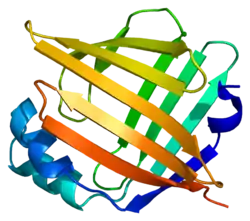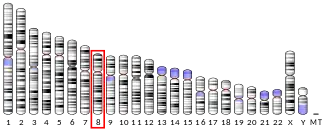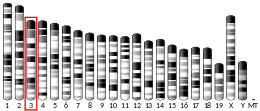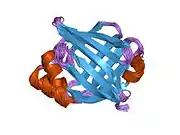Fatty acid-binding protein, epidermal is a protein that in humans is encoded by the FABP5 gene.[5][6]
Function
This gene encodes the fatty acid binding protein found in epidermal cells, and was first identified as being upregulated in psoriasis tissue. Fatty acid binding proteins are a family of small, highly conserved, cytoplasmic proteins that bind long-chain fatty acids and other hydrophobic ligands. It is thought that FABPs roles include fatty acid uptake, transport, and metabolism.[6]
The phytocannabinoids (THC and CBD) inhibit endocannabinoid anandamide (AEA) uptake by targeting FABP5, and competition for FABPs may in part or wholly explain the increased circulating levels of endocannabinoids reported after consumption of cannabinoids.[7] Results show that cannabinoids inhibit keratinocyte proliferation, and therefore support a potential role for cannabinoids in the treatment of psoriasis.[8]
Interactions
References
- 1 2 3 GRCh38: Ensembl release 89: ENSG00000164687 - Ensembl, May 2017
- 1 2 3 GRCm38: Ensembl release 89: ENSMUSG00000027533 - Ensembl, May 2017
- ↑ "Human PubMed Reference:". National Center for Biotechnology Information, U.S. National Library of Medicine.
- ↑ "Mouse PubMed Reference:". National Center for Biotechnology Information, U.S. National Library of Medicine.
- ↑ Madsen P, Rasmussen HH, Leffers H, Honoré B, Celis JE (September 1992). "Molecular cloning and expression of a novel keratinocyte protein (psoriasis-associated fatty acid-binding protein [PA-FABP]) that is highly up-regulated in psoriatic skin and that shares similarity to fatty acid-binding proteins". The Journal of Investigative Dermatology. 99 (3): 299–305. doi:10.1111/1523-1747.ep12616641. PMID 1512466.
- 1 2 "Entrez Gene: FABP5 fatty acid binding protein 5 (psoriasis-associated)".
- ↑ Elmes MW, Kaczocha M, Berger WT, Leung K, Ralph BP, Wang L, Sweeney JM, Miyauchi JT, Tsirka SE, Ojima I, Deutsch DG (April 2015). "Fatty acid-binding proteins (FABPs) are intracellular carriers for Δ9-tetrahydrocannabinol (THC) and cannabidiol (CBD)". The Journal of Biological Chemistry. 290 (14): 8711–21. doi:10.1074/jbc.M114.618447. PMC 4423662. PMID 25666611.
- ↑ Wilkinson JD, Williamson EM (February 2007). "Cannabinoids inhibit human keratinocyte proliferation through a non-CB1/CB2 mechanism and have a potential therapeutic value in the treatment of psoriasis". Journal of Dermatological Science. 45 (2): 87–92. doi:10.1016/j.jdermsci.2006.10.009. PMID 17157480.
- ↑ Ruse M, Broome AM, Eckert RL (July 2003). "S100A7 (psoriasin) interacts with epidermal fatty acid binding protein and localizes in focal adhesion-like structures in cultured keratinocytes". The Journal of Investigative Dermatology. 121 (1): 132–41. doi:10.1046/j.1523-1747.2003.12309.x. PMID 12839573.
- ↑ Hagens G, Roulin K, Hotz R, Saurat JH, Hellman U, Siegenthaler G (February 1999). "Probable interaction between S100A7 and E-FABP in the cytosol of human keratinocytes from psoriatic scales". Molecular and Cellular Biochemistry. 192 (1–2): 123–8. doi:10.1023/A:1006894909694. PMID 10331666. S2CID 24171894.
Further reading
- Rasmussen HH, van Damme J, Puype M, Gesser B, Celis JE, Vandekerckhove J (December 1992). "Microsequences of 145 proteins recorded in the two-dimensional gel protein database of normal human epidermal keratinocytes". Electrophoresis. 13 (12): 960–9. doi:10.1002/elps.11501301199. PMID 1286667. S2CID 41855774.
- Siegenthaler G, Hotz R, Chatellard-Gruaz D, Didierjean L, Hellman U, Saurat JH (September 1994). "Purification and characterization of the human epidermal fatty acid-binding protein: localization during epidermal cell differentiation in vivo and in vitro". The Biochemical Journal. 302 ( Pt 2) (2): 363–71. doi:10.1042/bj3020363. PMC 1137237. PMID 8092987.
- Maruyama K, Sugano S (January 1994). "Oligo-capping: a simple method to replace the cap structure of eukaryotic mRNAs with oligoribonucleotides". Gene. 138 (1–2): 171–4. doi:10.1016/0378-1119(94)90802-8. PMID 8125298.
- Siegenthaler G, Hotz R, Chatellard-Gruaz D, Jaconi S, Saurat JH (January 1993). "Characterization and expression of a novel human fatty acid-binding protein: the epidermal type (E-FABP)". Biochemical and Biophysical Research Communications. 190 (2): 482–7. doi:10.1006/bbrc.1993.1073. PMID 8427590.
- Masouyé I, Saurat JH, Siegenthaler G (1996). "Epidermal fatty-acid-binding protein in psoriasis, basal and squamous cell carcinomas: an immunohistological study". Dermatology. 192 (3): 208–13. doi:10.1159/000246367. PMID 8726632.
- Jaworski C, Wistow G (November 1996). "LP2, a differentiation-associated lipid-binding protein expressed in bovine lens". The Biochemical Journal. 320 ( Pt 1) (1): 49–54. doi:10.1042/bj3200049. PMC 1217896. PMID 8947466.
- Masouyé I, Hagens G, Van Kuppevelt TH, Madsen P, Saurat JH, Veerkamp JH, Pepper MS, Siegenthaler G (September 1997). "Endothelial cells of the human microvasculature express epidermal fatty acid-binding protein". Circulation Research. 81 (3): 297–303. doi:10.1161/01.res.81.3.297. hdl:2066/25768. PMID 9285630. S2CID 21737640.
- Suzuki Y, Yoshitomo-Nakagawa K, Maruyama K, Suyama A, Sugano S (October 1997). "Construction and characterization of a full length-enriched and a 5'-end-enriched cDNA library". Gene. 200 (1–2): 149–56. doi:10.1016/S0378-1119(97)00411-3. PMID 9373149.
- Watanabe R, Fujii H, Yamamoto A, Hashimoto T, Kameda K, Ito M, Ono T (November 1997). "Immunohistochemical distribution of cutaneous fatty acid-binding protein in human skin". Journal of Dermatological Science. 16 (1): 17–22. doi:10.1016/S0923-1811(97)00615-4. PMID 9438903.
- Hagens G, Masouyé I, Augsburger E, Hotz R, Saurat JH, Siegenthaler G (April 1999). "Calcium-binding protein S100A7 and epidermal-type fatty acid-binding protein are associated in the cytosol of human keratinocytes". The Biochemical Journal. 339 ( Pt 2) (2): 419–27. doi:10.1042/0264-6021:3390419. PMC 1220173. PMID 10191275.
- Hagens G, Roulin K, Hotz R, Saurat JH, Hellman U, Siegenthaler G (February 1999). "Probable interaction between S100A7 and E-FABP in the cytosol of human keratinocytes from psoriatic scales". Molecular and Cellular Biochemistry. 192 (1–2): 123–8. doi:10.1023/A:1006894909694. PMID 10331666. S2CID 24171894.
- Hohoff C, Börchers T, Rüstow B, Spener F, van Tilbeurgh H (September 1999). "Expression, purification, and crystal structure determination of recombinant human epidermal-type fatty acid binding protein". Biochemistry. 38 (38): 12229–39. doi:10.1021/bi990305u. PMID 10493790.
- O'Shaughnessy RF, Seery JP, Celis JE, Frischauf A, Watt FM (December 2000). "PA-FABP, a novel marker of human epidermal transit amplifying cells revealed by 2D protein gel electrophoresis and cDNA array hybridisation". FEBS Letters. 486 (2): 149–54. doi:10.1016/S0014-5793(00)02252-3. PMID 11113456. S2CID 23327194.
- Gutiérrez-González LH, Ludwig C, Hohoff C, Rademacher M, Hanhoff T, Rüterjans H, Spener F, Lücke C (June 2002). "Solution structure and backbone dynamics of human epidermal-type fatty acid-binding protein (E-FABP)". The Biochemical Journal. 364 (Pt 3): 725–37. doi:10.1042/BJ20020039. PMC 1222622. PMID 12049637.
- Gevaert K, Goethals M, Martens L, Van Damme J, Staes A, Thomas GR, Vandekerckhove J (May 2003). "Exploring proteomes and analyzing protein processing by mass spectrometric identification of sorted N-terminal peptides". Nature Biotechnology. 21 (5): 566–9. doi:10.1038/nbt810. PMID 12665801. S2CID 23783563.
- Ruse M, Broome AM, Eckert RL (July 2003). "S100A7 (psoriasin) interacts with epidermal fatty acid binding protein and localizes in focal adhesion-like structures in cultured keratinocytes". The Journal of Investigative Dermatology. 121 (1): 132–41. doi:10.1046/j.1523-1747.2003.12309.x. PMID 12839573.
- Ha MK, Chung KY, Lee JH, Bang D, Park YK, Lee KH (September 2004). "Expression of psoriasis-associated fatty acid-binding protein in senescent human dermal microvascular endothelial cells". Experimental Dermatology. 13 (9): 543–50. doi:10.1111/j.0906-6705.2004.00196.x. PMID 15335354. S2CID 22923459.






